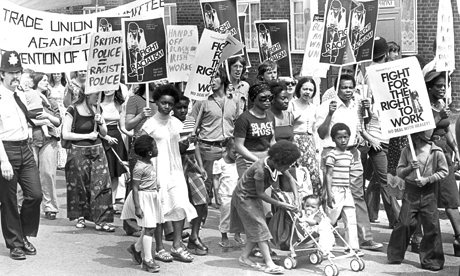Sankofa exhibition opens at Hackney Museum as part of Black History Month

Protesters taking part in an event called March Against Police Brutality in 1976
From the arrival of the Windrush generation in the post-war period to the rise of Black History Month, a new exhibition at Hackney Museum reflects on the histories of African and African-Caribbean people in Britain over the past 75 years through language, literature, politics, music, fashion and art.
Sankofa: The Truth behind Black History Month 1926-2013 highlights the history of protests and of resistance, particularly regarding education and policing, according to Patrick Vernon, a Hackney councillor and one of the exhibition’s curators.
“It’s really an attempt to challenge the dominant narrative of British history, providing some answers to real questions that are still being asked like: ‘Why are you here?'” says Mr Vernon. “It is important for people to see the reasons why we are here, the history behind it.”
Sankofa is the African Adinkra symbol of the importance of learning from the past to build a better future, and the exhibition acknowledges the work of pioneers like Oscar James and Alton Kumaloof, who founded the Temba Theatre Company in 1972 to promote new and established black writing.
In terms of visual arts, the work of black artists including Eddie Chambers, Sonya Boyce, Donald Rodney and Chris Ofili, winner of the Turner Prize in 1998, is explored.
Furnished with a collection of original posters, magazines, album covers, pamphlets and books from local residents and community and national archives, the real strength of the exhibition is in the attention it dedicates to the work of political activists and campaign groups such as the Black Parents Movement, Teachers Against Racism and the Hackney Black People’s Association.
Hard-won changes to government policy to help end racial discrimination and injustice are documented here and tributes are paid to the late political and cultural activist, poet and publisher John La Rose, who, from the mid-1960s, was a key figure in the Black Education Movement, fighting against the placing of African and African-Caribbean children in ESN (“educationally sub-normal”) schools.
Crucially, Sankofa also remembers tragedies such as the New Cross Fire in 1981, the attack on Trevor Moneville in 1987 and the deaths of Colin Roach in 1983 and Stephen Lawrence in 1993.
Funding for Black History Month has been radically cut as part of the government’s austerity measures. Sankofa is a timely reminder of its meaning and significance.
One of the exhibits on show is an original poster advertising the first Rock Against Racism march from Trafalgar Square to Victoria Park, where in the spring of 1978 bands including Misty in Roots, Matumbi and Steel Pulse played to a crowd of 100,000 demonstrators.
Ken Worpole, a Hackney-based writer on architecture and public policy, was at the concert, and his testimony in the exhibition recalls the remarkable mix of people who united to demonstrate – from punks and rastas to anarchists and earnest Christians.
“We had never seen anything like it before, or since,” says Worpole. “It was spontaneous, heartfelt and magnificent – one of the truly great demonstrations in London’s long history.”
Black History Month has its critics, and the curators of the exhibition haven’t shied away from taking a critical approach, asking: “Where has the history gone in Black History Month?”
Sankofa takes an important step towards reaffirming the value of that history.
Sankofa: The Truth behind Black History Month 1926-2013 is at Hackney Museum, 1 Reading Lane, E8 1GQ from 26 September until 4 January 2014
